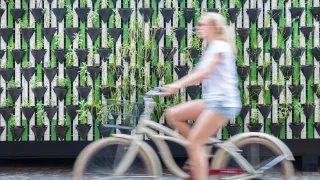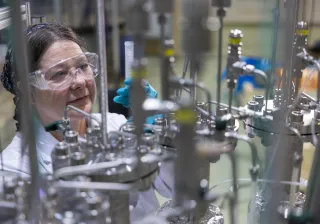The greater the reduction in friction and wear in machines and equipment, the greater the saving in energy and the reduction in greenhouse emissions. Digital modelling of materials enables machine design for better resistance to friction and wear, and the development of new types of materials.
Friction occurs when two surfaces rub against each other. Friction problems have been traditionally overcome by turning up the power, but we now need to save energy and reduce greenhouse gases.
– Today, a fifth of all energy is used to overcome friction. The biggest energy users are industry and transport, which use twothirds of the world's energy. Friction accounts for 30% of energy consumption in passenger cars. The corresponding figure for industry varies between 10 and 40 percent, says Research Professor Kenneth Holmberg of VTT.

Tribology is the study of friction
Tribology is a relatively new discipline, which emerged in the late 1960s and involves the study of friction, wear and lubrication. Tribology takes a multidisciplinary approach based on physics, chemistry, mathematics and machine design.
The International Energy Agency (IEA) has estimated that energy efficiency achieved through tribological methods will play a major role in limiting global warming to two degrees by 2050.
Many ways of reducing friction
– Completely new ways of reducing friction have been developed through tribology over the last 20 years. One way is to coat one of the surfaces with a slippery substance. The most slippery surfaces today are 100 times more frictionless than 20 years ago, Holmberg says.
Friction can also be reduced by altering the material, i.e. using very thin nanomaterials, metals or polymers. In addition, frictionreducing patterns, grooves or indentations, known as the material's topography, can be added to the surface of a material. The third way is to use lubrication and additives. Friction-reducing particles, such as graphene, are currently added to lubricating oil.
– Different ways of reducing friction are suitable for different types of objects. The lowest friction coefficient of 0.0005 has been achieved with carbon coating, under laboratory conditions. There are already commercial applications for carbon coatings, and various additives are being developed, Holmberg explains.
– A very low friction coefficient has also been achieved with biomolecules that mimic a joint function. This friction reduction method is partly based on biomimetics, which involves the mimicking of natural phenomena.
Digital material modelling
Computers have changed material research, which has traditionally been based on laboratory experiments.
– Computers were still not powerful enough just 20 years ago, but today's high performance computers can perform digital multi-scale modelling, macro and micro modelling, and atomic modelling. Material and its behaviour can be displayed on a computer screen, at different levels of the material structure and hierarchy, says Principal Scientist Anssi Laukkanen.
The object is typically shown from the outside in material modelling. However, the latest development is integrated digital material modelling, which also models the content. When the internal material structure of a machine can be observed, the viewer can see what kinds of stresses and fissures might occur.
– Depending on the goal, integration can be done in a number of ways, for example by linking together different scales from atomic to component level, or different time scales from picoseconds to millennia. Integration can also be performed by combining the material manufacturing process itself with the microstructure, properties or performance of the material, explains Laukkanen.
VTT models the microstructure of materials
– VTT is excellent at modelling the microstructure of materials and identifying friction contacts. We were the first in the world to develop an integrated digital material model that combines the actual surface of the material with a 3D structure, says Holmberg.
– We can go inside the material digitally and see how it behaves in different circumstances. We can show how the material behaves under loads, says Senior Scientist and Product Manager Tomi Suhonen.
– Digital modelling dispenses with the need to build a component from 50 materials and then perform tests to see how it behaves. Instead, changes are made to the component's structure within the computer model. This reveals the weak points in the material and issues such as the tensile stress at a particular point, explains Suhonen.
Modelling creates a huge quantitative database, which can be used to calculate trends and probabilities.
– We can make materials do what we want when they are in digital form. We can even model material that doesn't exist, to see what would happen if it could be made. We can design new materials and then investigate whether they would be worth developing, Holmberg explains.
Businesses are investing in friction research
Companies are now actively exploring the reduction of friction and wear in materials – new products that reduce energy consumption and greenhouse gas emissions will eventually enter the market. It has been estimated that R&D time could be halved by digital material modelling.
– The breakthrough for VTT's multiscale modelling tool, ProperTune®, occurred three years ago. The number of research assignments have multiplied since then, Tomi Suhonen explains.
Among other things, VTT's research expertise has been used to forecast wear in KONE Hissi's elevator mechanical systems, and for modelling the wear resistance of Metso Minerals' rock crushing equipment. ProperTune has also modelled the operation of automotive brakes and paper machine rolls, glass manufacturing, very high strength steels, components for the final disposal of spent nuclear waste, 3D-printed metal components, biopolymers and diesel engine components.
Research in this field is internationally networked. The various research institutes assist one another in their R&D.
Saving energy through tribology
– If coordinated investments were made in using tribology to reduce friction and wear, a global saving of 18% in energy consumption could be achieved in the short term, i.e. just 5–8 years. A 40% energy saving would be made in the long run, i.e. in 15 years, says Kenneth Holmberg.
The savings would vary between sectors. They would be greatest in the mining industry, even if new methods are slow to catch on in the sector. Short-term savings of 25 percent could be achieved in the case of heavy traffic, where new technology is rapidly introduced. This would save around 20% in energy production.
Curbing greenhouse emissions
– Greenhouse gas emissions are directly related to energy consumption, Holmberg says.
According to Holmberg, the introduction of advanced tribological methods could reduce worldwide carbon dioxide emissions by 1,460 million tonnes. In the short-term, this would mean cost savings of EUR 450,000 million. In the long run, it would be possible to reduce carbon dioxide emissions by 3,140 million tonnes, which would result in savings of EUR 970,000 million.
International recognition for world-class research
In December 2017, the Tribology Trust presented VTT Professor Kenneth Holmberg with the Tribology Gold Medal Award, the highest international award in the field, in recognition of his achievements as a tribologist. Holmberg is the first Finn to be awarded the prize.
Holmberg has three research focuses related to the reduction of friction and machine wear: thin surfaces such as nanostructured membranes, diamond-like carbon (DLC) coatings and graphene; modelling and digital design; and having a global impact. The related findings have visible impacts on the whole of society, in industry, power plants, transport and residential environments.
The Tribology Gold Medal Award was presented for the first time in 1972 and has been awarded to 38 people from 12 countries. The award is also known as the "Tribology Nobel prize", because it is awarded in a manner similar to the Nobel prize procedure.




